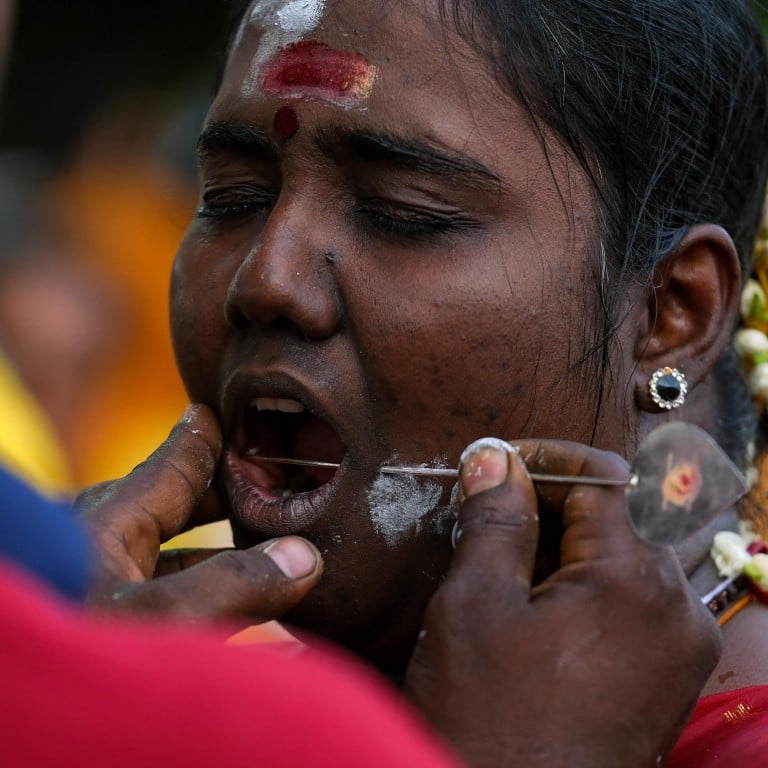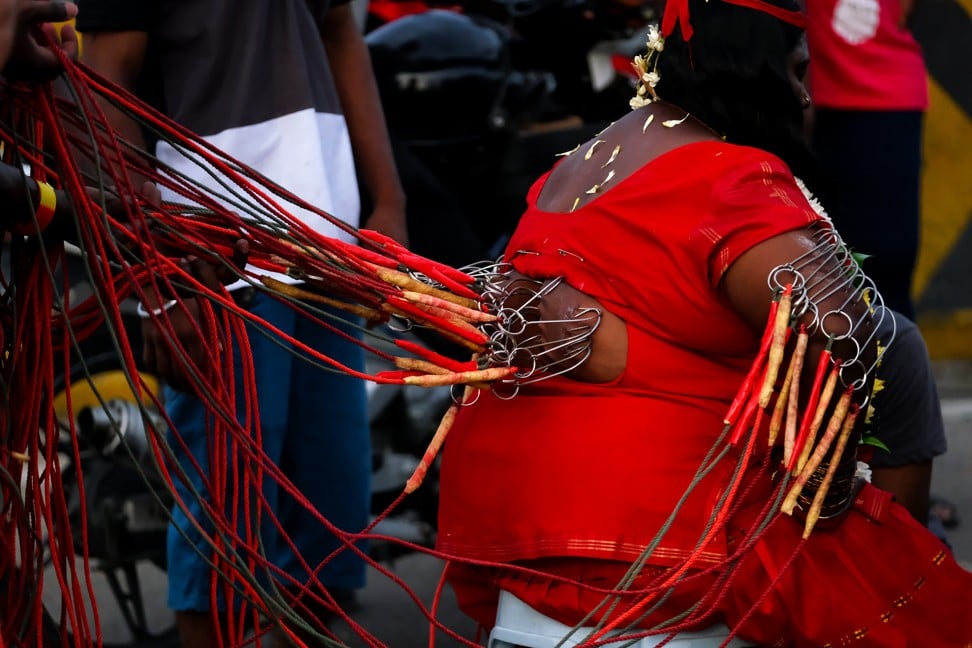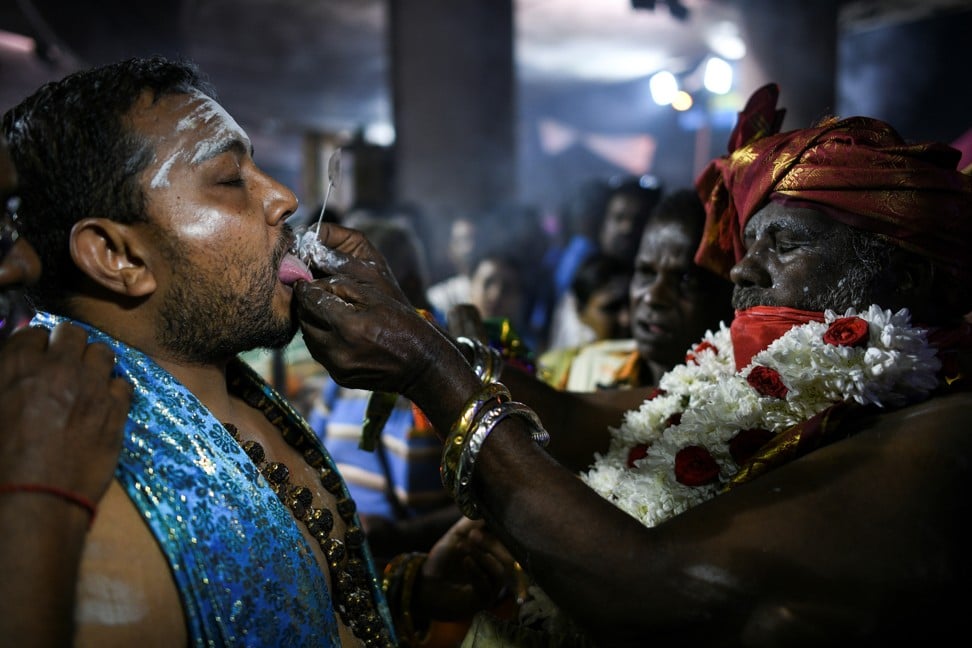
No pain? How extreme body piercing of Thaipusam Hindu festival devotees hurts piercers more than pilgrims
- From skewers though cheeks to sharp hooks embedded in backs, body piercers preparing pilgrims for Thaipusam have the Hindu festival’s most important job
- They claim their subjects do not feel pain; in fact, they can be the ones who suffer. We find out how, from inducing trances to fasting before piercing begins
The most striking feature of the Hindu festival of Thaipusam is devotees carrying symbolic burdens of gratitude, ranging from milk pots to complex arrangements of heavy ornaments. But they don’t use their hands. Instead, the objects are attached to their bodies with sharp rods and hooks.
A heady mix of religion, culture, determination and willpower, Thaipusam marks the day when the mythical Lord Murugan – dispenser of favours, and god of courage, wealth and wisdom – defeated an evil demon using a spear called a vel, and in doing so saved humanity.
The festival’s name is derived in part from the 10th month of the Tamil calendar, called “Thai”, and “pusam”, which means “when the moon is at its brightest”. It is celebrated during the full moon in the month of Thai, which usually falls in either January and February, and takes place this year on February 8.

Kavadis range in size and style from the humble paal kavadi – a pot of milk carried on the head – to elaborate constructions comprising decorative frameworks of steel rods and plywood, laden with heavy ornaments. Almost all have one thing in common, however. Carrying a kavadi involves some kind of body piercing to secure it.
This ritual of self-sacrifice, and the trancelike state devotees enter into when their skin is being pierced, is intended to defeat inner demons and gain Lord Murugan’s blessing.
Although the kavadi bearers are the centre of attention during Thaipusam, another group of people have the most important job and go largely unnoticed. They are the body piercers in whom the kavadi bearers must place their trust.
He may just be 25 but Yashven Raj has been practising body piercing for 10 years during Thaipusam, at the Batu Caves temple complex located on the outskirts of Kuala Lumpur, the Malaysian capital. The site is one of the best places to witness the grand celebrations.

At the Batu Caves, pilgrims walk barefoot for several kilometres and climb the 272 stairs leading to the temple of Lord Murugan, located in the limestone cavern above.
More than a million Hindu pilgrims from Malaysia and neighbouring countries visit the temple for the celebrations. Tourists look on agog at the spectacle of the kavadi bearers, family and friends show up in support, and the temple’s management allocates special lanes free of human traffic so pierced devotees can climb the steps unhindered.
Yashven Raj’s interest in body piercing was piqued after watching his father, Vigneswaran Thatchanamurthy, carrying out the task year after year.
“My father has been piercing bodies for 30 years now. There are people who would not let anyone touch their bodies except for my father. There are people who travel miles to get his service. I learned from the best,” Yashven Raj says.

He explains that body piercing is as intense an experience for the piercers as is it for the kavadi bearers.
For small kavadis, piercings are usually done on the tongue or cheeks with silver skewers that symbolise the vel. Heavy kavadis, some of which weigh up to 100kg (220lb), are secured with hooks that pierce a devotee’s chest and back. Some pilgrims even pull small chariots with thick ropes hooked into their backs. Others hook hundreds of tiny milk pots, or even fruits such as oranges and limes, onto their bodies.
If you are piercing someone’s back, you will feel the pain on your back. I have felt it myself, so it’s true. Those who get their bodies pierced report that they feel little to no pain
Yashven Raj, who is also a kavadi bearer himself, says body piercers usually observe the same period of abstinence as kavadi bearers.
“Body piercers mostly do the same. The days and type of abstinence may vary, but almost all of them observe some kind of [ritual] … I usually avoid eating meat for three days before performing body piercings on anyone.”

Yashven Raj says his toughest job to date was attaching 48 sharp metal hooks onto someone’s back.
“That was the most number of hooks I’ve worked with. It was pretty challenging as you have to be gentle enough to avoid inflicting pain and yet be firm enough for the hooks to go in and catch onto some flesh,” he explains. “My dad, who has pierced as many as 108 hooks [in a single person], taught me some chants that’s made the process much easier.”
According to Yashven Raj, a person does not feel pain when the skin is pierced because the body piercer absorbs the sensation.
“For example if you are piercing someone’s back, you will feel the pain on your back. I have felt it myself, so it’s true. Those who get their bodies pierced report that they feel little to no pain,” he says.
“As most of them vow to get their body pierced before they get into a trance, we know that they are alert when the pricks go in. They usually won’t even flinch, while those who are piercing would be wincing in pain.”

Akin to surgeons, body piercers concentrate intently as they work, poking the smooth membrane of skin with just the right amount of pressure to ensure there is no substantial blood flow.
Yashven Raj says that in his 10 years on the job, piercing bodies with sharp hooks will not usually draw blood.
“As strange as that sounds, it’s true. Even if there’s blood, only one or two drops of blood would come out. We would normally press the Thiruneeru, or sacred ash, onto the wound. However, we believe that the Thiruneeru produced today is very much processed with chemicals, so we simply wipe the blood spots with a clean cloth to maintain hygiene,” he explains.

For another body piercer, the real skill is drawing no blood at all. Tanarajoo Raman, who has five years’ experience, says this can be done by being steadfast in abstinence and fasting.
“I am absolutely strict when it comes to fasting before piercing a body. I fast for 48 days and only eat one meal during those days. The meal is completely vegetarian, with no eggs or meat,” he says.
“I only sleep on the ground during those 48 days, exchanging the soft, warm mattress for a cold, hard floor. I believe that my commitment to my fasting makes me pure, and that is why I’ve never seen pain or drawn blood when piercing any body.”

The 61-year-old says he stumbled upon body piercing unexpectedly.
“Five years ago, I was a spectator of the Thaipusam festival at the Batu Caves. My family and I were watching the myriad of kavadis makings their way into the Batu Caves and exiting the temple … when there was a call for help.” he says.
“A lady who was carrying [a pot of milk] needed her cheeks pierced with a vel spear and she was anxiously asking people to help her with it, as she did not bring a body piercer with her. She was almost begging for help and was on the verge of tears because she really wanted to pay her penance. That was when I stepped in to help. With no experience whatsoever, I pushed in the vel into one of her cheeks until it pierced through her other cheek,” he says.
“I was immensely proud of myself and I became a body piercer from then on, helping people to fulfil their vows.”
